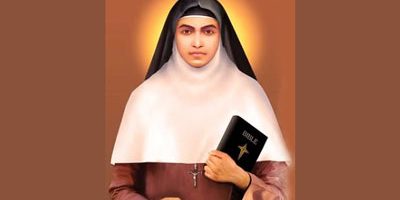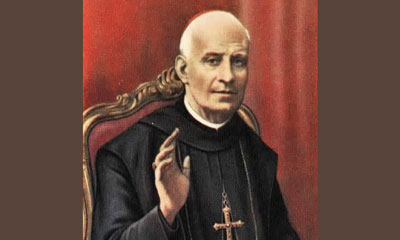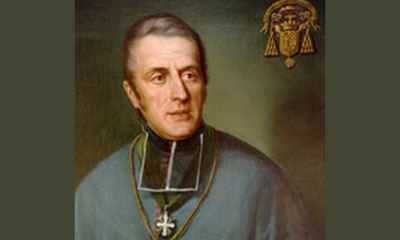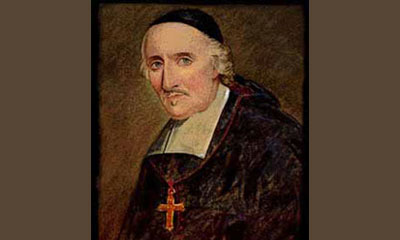November 9, 2017
Saint Alphonsa Muttathupadathu
Dear Friends,
“He will swallow up death for ever, and the Lord God will wipe away tears from all faces (Is. 25:8). These words of the prophet Isaiah,” said Pope Benedict XVI, during the canonization of Saint Alphonsa of the Immaculate Conception, “contain the promise which sustained Sister Alphonsa throughout a life of extreme physical and spiritual suffering. This exceptional woman, who today is offered to the people of India as their first canonized saint, was convinced that her Cross was the true way to arrive at the heavenly banquet prepared for her by the Father. In accepting this invitation to the wedding feast, and clothing herself with God’s grace through prayer and penance, she conformed her life to Christ’s and now delights in the rich fare and choice wines of the heavenly kingdom (cf. Is. 25:6)” (October 12, 2008).
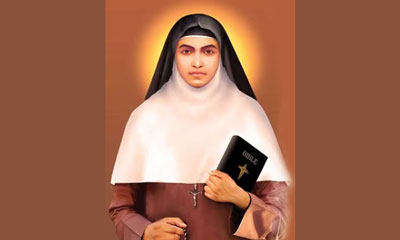 Anna Muttathupadathu was born on August 19, 1910, in Kudamaloor, in the state of Kerala, in southwest India. Her family belonged to the Syro-Malabar Catholic Church, the origins of which go back to Saint Thomas the Apostle. She was the fifth child of an old Christian family, poor but very dignified. Her father was a doctor, who practiced a form of traditional Indian medicine that did not include idolatry. Anna was only three months old when she lost her mother. Entrusted to an aunt who took charge of her education and a great-uncle who was a priest, she lived with her grandparents. She was given the nickname “Annakutti.” Her mother’s absence marked her deeply, as did the serious dissensions that disrupted family life. Her grandmother often took her to Mass, even during the week, and taught her the basics of the faith.
Anna Muttathupadathu was born on August 19, 1910, in Kudamaloor, in the state of Kerala, in southwest India. Her family belonged to the Syro-Malabar Catholic Church, the origins of which go back to Saint Thomas the Apostle. She was the fifth child of an old Christian family, poor but very dignified. Her father was a doctor, who practiced a form of traditional Indian medicine that did not include idolatry. Anna was only three months old when she lost her mother. Entrusted to an aunt who took charge of her education and a great-uncle who was a priest, she lived with her grandparents. She was given the nickname “Annakutti.” Her mother’s absence marked her deeply, as did the serious dissensions that disrupted family life. Her grandmother often took her to Mass, even during the week, and taught her the basics of the faith.
The Second Vatican Council emphasizes in our time the importance of education given within the family: “Since parents have given children their life, they are bound by the most serious obligation to educate their offspring and therefore must be recognized as the primary and principal educators. This role in education is so important that only with difficulty can it be supplied where it is lacking. Parents are the ones who must create a family atmosphere animated by love and respect for God and man, in which the well-rounded personal and social education of children is fostered. Hence the family is the first school of the social virtues that every society needs. It is particularly in the Christian family, enriched by the grace and office of the sacrament of matrimony, that children should be taught from their early years to have a knowledge of God according to the faith received in Baptism, to worship Him, and to love their neighbor. Here, too, they find their first experience of a wholesome human society and of the Church. Finally, it is through the family that they are gradually led to a companionship with their fellowmen and with the people of God” (Gravissimum educationis, no. 3).
A royal path
Impressed from her childhood by the life of Saint Thérèse of Lisieux, who, like her, had lost her mother, Annakutti resolved to become a saint herself through prayer and penance. Her way to holiness would be “the way of the Cross, the way of sickness and suffering” (Saint John Paul II). She would consider this to be a royal road to conformity with Christ. To advance on it, she was helped by her devotion to Father Chavara, a priest who had worked in Kerala the previous century.
Born on February 10, 1805, Cyriac Elias Chavara became a priest of the Syro-Malabar Church and a Carmelite monk. He formed the Congregation of the Servants of Mary Immaculate of Mount Carmel and the Sisters of the Mother of Carmel. Named vicar general of the Syro-Malabar Church in 1861, he proved to be a great promoter of Church unity, and dedicated himself to the spiritual renewal of the Syro-Malabar Christian community. A man of prayer, he stood out in his love for Jesus in the Blessed Sacrament and his special devotion to Mary, the Immaculate Virgin. He rendered his soul to God in 1871 (cf. Letter from the Abbey, February 18, 2000). He was canonized in 2014.
Christianity took root very early on in India, especially in the southeast (present-day State of Kerala). Originally the Malabar Church was under the jurisdiction of the patriarchate of Antioch, and followed the Eastern Syrian Rite and its customs. But in the seventeenth century, it was placed under the direct jurisdiction of the Roman Church, and adopted its customs. Some of the Christians rejected this change and placed themselves under the authority of the Syrian Orthodox Church, not in union with Rome. The Syro-Malabar Catholic Church is the branch that remained united to Rome.
Particularly happy
From her youth, Annakutti led the daily prayers in her family, in the room that every Syro-Malabar home in Kerala keeps for this use. On November 11, 1917, at the age of seven, in accordance with the directives of Pope Saint Pius X, she made her first Holy Communion. Afterwards, she would often repeat to her friends: “Do you know why I am so particularly happy today? It’s because I received Jesus in my heart!” From that day on, she was very much aware that she belonged completely to God. Much later on, in 1943, in a letter to her spiritual director, she would write: “From the age of seven, I was no longer my own. I had completely given myself to my divine Spouse. Your Reverence knows this well.” Annakutti was ten years old when she was placed under the direct supervision of her aunt Annama, to whom she was very obedient. Three years later, her aunt decided that Annakutti should marry, according to the Indian custom. The girl was beautiful and, although she didn’t have a dowry, there was no shortage of suitors. Annakutti rejected the proposals of marriage with all her might. As a last resort, she decided, with more courage than wisdom, to burn one of her feet, thinking that no one would want to marry her if her body was damaged. In fact, the burn was serious, and she would later say: “Oh! How I suffered! I offered everything for my great intention (to belong completely to God)!” It took several years for the injury, and the pain she suffered walking, to fade. Nevertheless, the injury did not dissuade her suitors. After a second unsuccessful attempt, her aunt abandoned her program of marriage, yet she forbade the young woman from visiting the nearby Carmelites, and withdrew her from their school to put her in another one. Annakutti was friendly, straightforward and modest, and took advantage of her companions’ fondness for her to take them to hear homilies and pious talks. She also gladly helped them in their studies, without losing sight of her vocation, for she remained very determined to devote herself to God. Once when she visited family friends, someone remarked that she would make a good wife for one of the boys. From then on, she decided never to set foot in that house again.
In spite of her obedience, Annakutti sometimes incurred the wrath of her aunt Annama. Her aunt was very devout and went to Mass every day, but was very strict with everyone. Nevertheless, she had a special affection for Annakutti, which manifested itself in her insistence that she wear nice clothes and jewelry to go to school. The girl was upset even more upset by her friends teasing her about it. As much as she could, she immersed herself in an intense communion with the Lord, and discretely made many sacrifices. For example, she helped the servants in the kitchen and with the housework, even sometimes giving them some of her food, without letting her aunt know. She would later recognize that her aunt’s strictness and many demands had prepared her for the sacrifices that would be required by life in the novitiate.
An important comment
“I would like to add here another brief comment with some relevance for everyday living,” wrote Pope Benedict XVI in the Encyclical Spe Salvi. “There used to be a form of devotion—perhaps less practiced today but quite widespread not long ago—that included the idea of ‘offering up’ the minor daily hardships that continually strike at us like irritating ‘jabs’, thereby giving them a meaning. Of course, there were some exaggerations and perhaps unhealthy applications of this devotion, but we need to ask ourselves whether there may not after all have been something essential and helpful contained within it. What does it mean to offer something up? Those who did so were convinced that they could insert these little annoyances into Christ’s great ‘compassion’ so that they somehow became part of the treasury of compassion so greatly needed by the human race. In this way, even the small inconveniences of daily life could acquire meaning and contribute to the economy of good and of human love. Maybe we should consider whether it might be judicious to revive this practice ourselves” (November 30, 2007, no. 40).
On Pentecost 1927, counseled by an uncle who was a priest and the chaplain to the community, Annakutti entered the Poor Clares at Bharananganam. She was seventeen years old. This convent belonged to a branch of the order founded in Kerala in the nineteenth century, and which at the time numbered twenty-three houses. In 2008, there would be seven hundred forty, most of them in India. The nuns cared for orphans and the sick. According to the congregation’s practice, the young aspirant followed two years of formation, first as a student then as a postulant. She had no difficulty adapting to the discipline of the house, which seemed to her less demanding than her aunt’s severity. On August 2, 1928, when she became a postulant, she took the name of the saint of the day, Saint Alphonsus Liguori. From then on, she would be called Sister Alphonsa of the Immaculate Conception. However, she still had to resist a final attempt by her aunt, her father, and even, for a while, by her novice mistress, to marry her off. In this storm, the young nun demonstrated a great steadfastness. “Oh, the vocation I’ve received!” she would later say. “A gift from God… God knows the suffering in my soul in these days. He has taken away the difficulties and placed me in religious life.”
The poorest Order
In 1929, Sister Alphonsa was sent with another postulant to a convent of Adorers of the Blessed Sacrament for additional formation. Charmed by her talents, the Adorers tried to keep her in their house. Sister Alphonsa replied with a pleasant smile that her vocation was with the poorest order, that of Saint Claire. The following year, she received the Poor Clares’ habit, but her entrance to the novitiate was delayed. In fact, Mother Ursula, the superior, had been influenced by criticisms leveled against Sister Alphonsa by certain sisters who were jealous of her natural and supernatural qualities. Moreover, she feared that her apparently fragile health would not endure the rigors of the Rule. The bishop of the diocese himself intervened to examine the postulant’s aptitudes. It is true that during this time Sister Alphonsa suffered serious health problems. However, she diligently endeavored to lead a fervent religious life, and noted, “I will neither act nor speak according to my inclinations… I will watch that I never rebuff anyone. I will always speak to others with gentleness. I will rigorously control my eyes. I will ask pardon of the Lord for every little fault and I will reconcile myself with Him by doing penance. No matter what my sufferings may be, I will not complain, and if I suffer a humiliation, I will take refuge in the Sacred Heart of Jesus.”
The constitutions of the Poor Clare sisters required a dowry of 800 rupees for any postulant admitted to the novitiate. The families of the other seven postulants were able to pay this sum, but Sister Alphonsa’s father did not have the means. Even after selling the gold he had inherited from his mother, he could come up with only 500 rupees. A generous gift from Mother Ursula’s family and a loan from a priest, who would refuse repayment, made up the difference. On August 12, 1935, Sister Alphonsa finally became a novice and, one year later, she took her vows: “Tell our father,” she wrote to her sister, “that I am well and at peace. The Lord has given me the grace to become a real nun. He has given me the special grace of suffering with Jesus. That is the most precious gift that my divine Spouse could give me. So, rejoice with me.”
“The Christian faith,” teaches Pope Benedict XVI, “has shown us that God —Truth and Love in person—desired to suffer for us and with us … Man is worth so much to God that he himself became man in order to suffer with man in an utterly real way—in flesh and blood—as is revealed to us in the account of Jesus’s Passion. Hence in all human suffering we are joined by one who experiences and carries that suffering with us; hence consolation is present in all suffering, the consolation of God’s compassionate love—and so the star of hope rises” (Encyclical Spe Salvi, no. 39).
A constant smile
Having fallen gravely ill, Sister Alphonsa made a novena to Father Chavara and immediately recovered. Another time, she was healed after an apparition of this Father, followed by Saint Thérèse. When her health allowed, Sister Alphonsa taught in the school run by her congregation. She possessed a particular gift for making herself loved by the students and leading them to the Lord. Her beautiful handwriting earned her a position as a secretary for writing official letters. Her bearing and demeanor manifested an extraordinary serenity. She maintained her smile even in suffering, and seized every opportunity to make sacrifices. In 1939, she was weakened by a severe case of pneumonia. Two years later, during another illness, she received last rites.
In July 1945, a gastroenteritis, complicated by liver problems, caused her violent convulsions and vomiting, which mysteriously occurred every Friday. One day, she asked her superior for permission to beg the Lord for the grace that her daytime pains and discomfort be transferred to nighttime, explaining, “If I suffer at night, I remain alone and don’t bother anyone. On the other hand, if I suffer during the day, the sisters become aware of it, and do everything they can to comfort me; I inconvenience them.” In spite of all her sufferings, she constantly kept a friendly smile on her lips, and was as gay as a child. “[S]he continually gave thanks to God for the joy and privilege of her religious vocation, for the grace of her vows of chastity, poverty and obedience… She came to love suffering because she loved the suffering Christ, and to love the Cross through her love of the crucified Lord” (Homily for the beatification, February 8, 1986). One day Sister Alphonsa explained, “The grains of wheat ground at the mill become flour. And with this flour, hosts for the Holy Eucharist are made. The grapes crushed in the wine press yield the juice that will become wine. Similarly, suffering crushes us and thus we become better.” To her physical sufferings were added those caused by misunderstanding, jealousy, and false judgments of her. But she strove to redouble her charity towards those were tempted against her, and declared, “Even if I were accused without having done anything wrong, I would be content with saying: ‘I’m sorry. Excuse me.’” In a letter of February 1946, shortly before her death, she wrote, “I have completely given myself to Jesus. May He do with me as He wishes. My only desire in this world is to suffer for the love of God and to rejoice in doing so.”
Faced with the certainty of the bedridden Sister Alphonsa’s imminent end, her spiritual director suggested to the Mother Superior that she have her put into writing her “spiritual experiences.” Mother Ursula conveyed the request, but, to her great surprise, the sick woman did not respond immediately, as though weighing an important decision. She then burst into tears: “Is it strictly necessary that I write about myself? Nothing in my life is worth being remembered. However, it is true that I have written for myself some little spiritual notes. They are in the dresser. I ask that you destroy them.” In the face of Mother Ursula’s refusal, she continued, “Mother, for the love of God, no one should know anything of me… I am a very stupid person, a worm. But if it is God’s will, He will find a way. Look what He did in the case of Mary of Egypt.”
Saint Mary of Egypt was a prostitute in Alexandria, living during the time of the Desert Fathers (the 5th century). She converted, and lived in the desert as a penitent for forty-seven years, without anyone knowing of it. She was finally discovered by the abbot of a community in the area who, to cover her nakedness, gave her his mantle. On Holy Thursday, he brought her Communion. The following year, he returned to repeat the gesture, but found her dead. He had her buried. Thereafter, spontaneously, Christians began visiting her tomb, which became a pilgrimage site to which pilgrims came from as far away as Europe.
Yielding to Sister Alphonsa’s pleas, the superior tore up the notes, and the sick woman regained her peace. But, just as she had predicted, her reputation for holiness spread like wildfire after her death. Her life has been able to be pieced together, and her spirituality understood and made known, thanks to the testimony of people who visited her and the letters she wrote.
They did not hear them
Sister Alphonsa became progressively weaker. She often spoke of her impending death, peacefully and often in very poetic terms: “The little birds climb to heaven with such lightness that we do not hear them beat their wings. I will do likewise when my Lord and Master calls me to Him.” On July 27, 1946, she announced, “Tomorrow there will be a great battle.” It was thought that she was alluding to a new attack of pain, since she often felt them coming on, and would ask her sisters beforehand to pray for her. But later, they realized that she had never used the word “battle” in those cases. The following day, a Sunday, feeling better, she dressed and went to the chapel for the office. But, overcome by a sudden nausea, she withdrew to her cell. Her pains intensified. Murmuring “Jesus, Mary, Joseph,” she lost consciousness and died. Perhaps she was reciting in her heart, one last time, the prayer that she herself had composed: “O Jesus, hide me in the sacred wound of Your Heart. Deliver me from the disordered desire to want to be loved and esteemed. Save me from the pathetic pursuit of love and fame. Make me so humble as to become absolutely nothing, a tiny spark of the fire of love that sets Your Sacred Heart ablaze. Grant me the grace to completely forget both myself and other creatures.” She was thirty-six years old.
During the funeral, a Sister who was suffering from intense and persistent back pain offered, despite the pain, to carry the coffin from the convent to the parish church. During the procession, she was instantly and completely healed. Sister Alphonsa of the Immaculate Conception was beatified by Saint John Paul II during his apostolic visit to Kerala in 1986, and canonized in 2008 by Benedict XVI at Saint Peter’s in Rome.
“She wrote,” observed Benedict XVI during the canonization, ‘I consider a day without suffering to be a day lost’. May we imitate her in shouldering our own Cross so as to rejoin her one day in paradise.”


